Defenses for Spring 2016
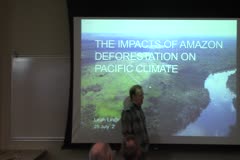
The Impacts of Amazon Deforestation on Pacific Climate
July 25, 2016
Leah Lindsey
Variability in eastern Pacific sea surface temperatures (SSTs) associated with the El Niño Southern Oscillation are known to affect Amazonian precipitation, but to what extent do changing Amazonian vegetation and rainfall impact eastern Pacific SST? The Amazon rainforest is threatened by many factors including climate change and clearing for agricultural reasons. Forest fires and dieback…
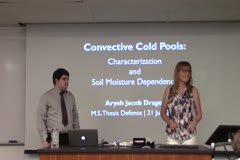
Convective Cold Pools: Characterization and Soil Moisture Dependence
July 21, 2016
Aryeh Drager
Convective cold pools play an important role in Earth's climate system. However, a common framework does not exist for conceptually defining and objectively identifying convective cold pools in observations and models. The first part of this thesis begins with a review of the identification methods used in previous works. This is followed by an investigation of convective cold pools within a…
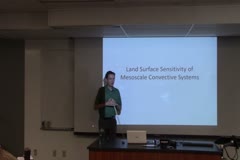
Land Surface Sensitivity of Mesoscale Convective Systems
July 08, 2016
Robert Tournay
Mesoscale convective systems (MCSs) are important contributors to the hydrologic cycle in many regions of the world as well as major sources of severe weather. MCSs continue to challenge forecasters and researchers alike, arising from difficulties in understanding system initiation, propagation, and demise. One distinct type of MCS is that formed from individual convective cells initiated…
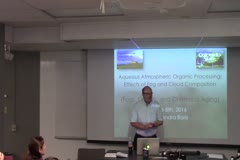
Aqueous Atmospheric Organic Processing: Effects of Fog and Cloud Composition
June 08, 2016
Ali Boris
Cloud and fog droplets are well-suited venues for organic reactions leading to the formation of suspended particulate matter in the atmosphere. Suspended particular matter formed through aqueous reactions is called "aqueous secondary organic aerosol" or aqSOA, and can interact with solar radiation and adversely impact human ecosystem health. Although atmospheric observations and lab simulations…
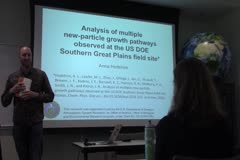
Analysis of multiple new-particle growth pathways observed at the US DOE Southern Great Plains field site
April 21, 2016
Anna Hodshire
New-particle formation (NPF) is a significant source of aerosol particles to the atmosphere. However, these particles are initially too small to have climatic importance and must grow, primarily through net uptake of low-volatility species, from diameters 1 nm to 30-100 nm in order to potentially impact climate. There are currently uncertainties in the physical and chemical processes associated…

INTERACTIONS OF ARCTIC CLOUDS, RADIATION, AND SEA ICE IN PRESENT-DAY AND FUTURE CLIMATES
February 23, 2016
Melissa Burt
The Arctic climate system involves complex interactions among the atmosphere, land surface, and the sea-ice-covered Arctic Ocean. Observed changes in the Arctic have emerged and projected climate trends are of significant concern. Surface warming over the last few decades is nearly double that of the entire Earth. Reduced sea-ice extent and volume, changes to ecosystems, and melting permafrost…
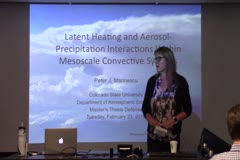
LATENT HEATING AND AEROSOL-PRECIPITATION INTERACTIONS WITHIN MESOSCALE CONVECTIVE SYSTEMS
February 23, 2016
Peter Marinescu
Two studies are presented in this thesis that focus on understanding cloud processes within simulations of two mesoscale convective system (MCS) events that occurred during the Midlatitude Continental Convective Clouds Experiment (MC3E). Simulations are conducted with the Regional Atmospheric Modeling System (RAMS) and are compared with a suite of observations obtained during MC3E. It is…
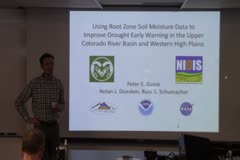
Maximizing the Utility of Available Root Zone Soil Moisture Data for Drought Monitoring Purposes in the Upper Colorado River Basin and Western High Plains, and Assessing the Interregional Importance of Root Zone Soil Moisture on Warm Season Water Balance
February 08, 2016
Peter Goble
Root Zone Soil Moisture (RZSM) data has both drought monitoring and seasonal forecasting applications. It is the lifeblood of vegetation, a large component of the hydrologic system, a determining factor in irrigation scheduling, and works to govern the means by which energy imbalances are settled between land and atmosphere. The National Integrated Drought Information System (NIDIS) has worked…
